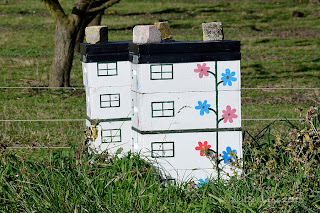Unfortunately a significant "weather event" was forecast, a large cold front sweeping up from the Antarctic & due to arrive in the North Island on the day we were going to leave. Snow & gale force winds were expected especially through the Central Plateau and if we got stuck up there we'd have no way of getting home until the snow melted. The roads through the Plateau are usually closed as soon as there is a heavy dump of snow. That & the fact that we didn't have any heating were of concern so we decided to wait it out a couple of days before heading anywhere. Strong winds had already started buffeting the van even though is was relatively sheltered beside the house & rain had began to fall.
Going by all the road reports & news articles we were then worried that the road home, the Napier-Taupo was going to close due to snow as well. By Saturday we decided it was time to head out, we'd changed our plans & were going to stop for a couple of nights at Lake Okareka near Rotorua which is on the way home. The Napier-Taupo was open although the AA Report said to watch for snow. I was secretly hoping that there was going to be a good photo opportunity once we got up into the ranges but disappointingly this was the only snow we saw, way over on top of the Kawekas. The road was bone dry too so no chance of black ice either which was good.
We pulled into DOC's Lake Okareka campground late in the afternoon. This is a small campground surrounded by bush & right on the shore of the lake. It has just twelve camping sites, they are all marked out & you take your pick. We both decided we didn't really like the regimented way this camp site works, in the busy season it would be full every night, with everyone lined up alongside each other like sardines. It was fine at this time of the year though & pleasant enough for a night or two.
There was a tent (bloody hell, they must be hardy) already set up & only us on the hard ground. Five more vans of various shapes & sizes trickled in over the next hour and we were all settled in by the time the sun dipped behind the hill.
The campsite overlooks the small but beautiful lake and other than one small boat out trout fishing the lake was deserted.
Just on dusk we took a walk through the bush, along a track than followed the shoreline. It wasn't very well maintained and we had to brush past gorse & blackberry at one stage and climb over fallen trees. It didn't look like it was going to be of much interest until we startled a morepork (Maori name; ruru) out of a tree fern. Ruru are New Zealand's only native owl & while most of us would have heard their distinctive call not many have seen one.
First thoughts were that it was a blackbird but I knew from the silent 'whoosh, whoosh" & the bigger size that it wasn't. And sure enough, David had spotted where it landed & I was able to creep up on it and take this shot. It was very alert & was on the verge of flying every step I took.
Not only was I thrilled with this shot because it's without flash in the very dark bush on dusk & handheld at a low shutter speed. Which would usually make it nearly impossible to get a sharp focus. But I nailed it. And, it's my very first "Explore" shot on Flickr. For those that don't know, Flickr is a photo sharing site, I use it to upload, store & share my photos. Flickr receives around 6,000 uploads every minute - that's about 8.6 million photos a day. From this huge group of images, Flickr choose only 500 images to showcase for each 24-hour period. That's only one image in every 17,000. And my Ruru was one of those on June 24th! Here's the link if you would like to read the comments.
We continued on to the end of the track now acutely aware of any movement around us. There were no other birds let alone another morepork. The track ended on a small point that reached out into the lake with a big drop off into the water below. We were just in time to see the last sun of the day & return along the track before it was pitch black.
Once the sun disappeared the temperature plummeted & without heating in the van we quickly put on extra layers of clothes. But it didn't help much and by 7:30pm we were tucked up in bed with as many blankets as we had available piled on top. I'll spare you the details of the clothing I wore to bed suffice to say that only my nose got cold that night. It actually wasn't too bad until you had to get up for the bathroom. I checked the temperature gauge at 12 midnight & it was 7c inside the van & 1.7c outside! Here's what it was in the morning at 8:30am; 4.4c inside & 1.8c outside, along with a good coating of frost on the ute.
Needless to say we didn't get out of bed until around 10:30am, the most time I've spent in bed for a very long time! The fact that the sun didn't pop it's head above the hill next to us until after 11 o'clock hadn't help with warming up the campground either. When we finally made an appearance outdoors everyone else had left!












.jpg)


.jpg)














.jpg)
.jpg)


